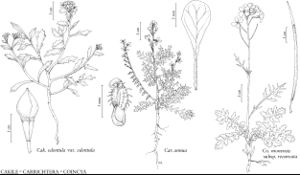Difference between revisions of "Carrichtera annua"
Mém. Mus. Hist. Nat. 7: 250. 1821.
Basionym: Vella annua Linnaeus Sp. Pl. 2: 641. 1753
Treatment appears in FNA Volume 7. Treatment on page 429.
imported>Volume Importer |
imported>Volume Importer |
||
| Line 54: | Line 54: | ||
|publication year=1821 | |publication year=1821 | ||
|special status= | |special status= | ||
| − | |source xml=https:// | + | |source xml=https://bitbucket.org/aafc-mbb/fna-data-curation/src/2e0870ddd59836b60bcf96646a41e87ea5a5943a/coarse_grained_fna_xml/V7/V7_642.xml |
|tribe=Brassicaceae tribe Brassiceae | |tribe=Brassicaceae tribe Brassiceae | ||
|genus=Carrichtera | |genus=Carrichtera | ||
Latest revision as of 22:35, 5 November 2020
Stems branched basally and distally, (0.5–)0.7–3.6(–4.5) dm. Basal leaves: petiole 1–4.5 cm; blade 3–6 lobes each side, 1.5–4 cm, terminal lobe linear to oblong, 0.3–1.5 cm × 0.5–1.5 mm, margins entire. Cauline leaves similar to basal. Fruiting pedicels 2.5–4 mm. Flowers: sepals 4–5 mm; petals 6.5–8 × 1–2 mm; median filaments 3.5–4 mm; anthers 0.5–0.8 mm. Fruits reflexed; proximal segment broadly ovoid to subglobose, 3–4 × 2.5–3.5 mm; terminal segment cochleariform or ovate, 3–5 × 3–4 mm (margin incurved). Seeds 1.1–1.6 mm diam. 2n = 16.
Phenology: Flowering Apr–May.
Habitat: Deserts
Elevation: ca. 50 m
Distribution

Introduced; Calif., sw Europe, sw Asia, n Africa, introduced also in Australia.
Discussion
Carrichtera annua was found as a naturalized weed in southern California in 2007.
Selected References
None.
Lower Taxa
None.
